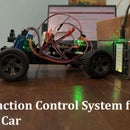Introduction: Electrostatic Smoke Precipitation
It is a method to remove smoke particles (particulate matter) from the air flow. This method makes use of high voltage to separate smoke particles. An alternate method can be to use very fine filter medium to separate these smoke particle, but in that case, that filter will add extra resistance to flow resulting in pressure drop. where this method adds very low or no resistance to the air flow.
Smoke particles are ionized and trapped using another plate having opposite sign of charge. Particle attracted towards charged plates and separated from the flow. This type of devices is generally used to collect ash after coal burning. This is one of the important industrial application, where PM or dust particle need to remove from the waste gas stream.
In this instructable,
this method of some precipitation is explained and also demonstrated.
Video of working: https://youtu.be/93KDt3axvzw?t=4m39s
Step 1: Working:
In an electrostatic precipitator, smoke is charged using a high voltage electrode and passed over another electrode having opposite charge. so ionized particles attract towards it and separated from the gas stream.
In the image, a layout diagram plate precipitator configuration and actual industrial setup are given. The initial stage, smoke is passed through the negative electrode (blue coloured rod). This electrode has high voltage such that smoke particle gets ionized due to corona discharge (A beautiful phenomenon naturally occurs near sharp electrode containing charges at high voltage, where air around it get ionized and the bluish glow appears around it along with whistling noise). These ionized particles are passed though positively charged plate. These charged particles are attracted towards positive electrode due to the electrostatic force. So the layer of particle builds upon the electrode and separated from the flow.
Image source:
1. https://en.wikipedia.org/wiki/File:Electrostatic_...
Step 2: Material Required:
Making smoke precipitator for demonstration purpose is fairly simple (and inexpensive as well). But to make one for the actual application, it is required to consider multiple parameters that affect collection efficiency. So in this instructable, we would try to make a smoke precipitator that just works (no optimization).
To make electrostatic smoke precipitator following material would be required:
- The high voltage source, It can be an induction coil, ignition coil, Tesla coil. (Here I am going to use a ready-made high voltage module available on hobby market at a cheap rate typically known as 3.7V-6V to 400kV DC step up power module (output is not 400kV)) and appropriate battery to power it.
Some examples of these modules are shown in image. - Smoke source, ex. incense, a cigarette would work.
- Aluminium foil,
- Copper wires,
- Plastic bottles (or anything made of insulating material can be used as a container)
Apart from this basic tools like a cutter and glue gun would be helpful.
Step 3: Preparing Electrodes
First, we need to prepare a negative electrode using some branched wire. I have made it by soldering multiple copper wire to each other. Having multiple sharp edges will increase corona discharge so the ionization of the smoke. Instead of branched copper wire, simply multiple multiple wires in line can also be used.
This wire branch needs to fix with a container such that entering smoke first interact with these wire. Here I had attached wire branches to the neck of the plastic bottle. there is also one provision/cut on the bottom to place some smoke source. we will apply the negative charge to this electrode. So first smoke will interact with this electrode and ionize, then it will go to positive electrodes.
To make a container with a positive electrode two paper cups are used. I have placed Aluminium foil inside and made a hole on both upper and lower side from which smoke can enter and exit. A wire is connected with it that goes to the positive terminal of the high voltage supply. The module I am using does not have any type of indication for positive or negative. Identifying the negative terminal is not difficult just place a candle flame in between two plates (no electric breakdown or corona discharge in-between so ionized should be far enough with each other). Flame get attracted towards one of the terminals, that is negative.
Step 4: Final Setup and Run
Now a setup needs to prepare such that smoke first enters through the bottle, interact with branched copper wire/negative electrode, interact with Al foil/ positive electrode and exit. To have the proper visualisation of smoke light can be applied at the backside of the smoke. Refer image or video to see the setup I used.
Now complete setup is ready to be tested. First place smoke source (ex. incense or cigarette-like source) and observe smoke out from upper face. After turning ON the high voltage source and keep observing it for a few seconds. A significant reduction in smoke output can be observed. After a run few minutes, deposition at the positive electrode can be observed. But Typically these power supplies are not designed to work for more than a half or one minute. So this factor needs to be considered while doing the experiment.
High Voltage hazards:
This supply can generate thousands of voltage but these are not at all lethal as it cannot sustain these value of voltage once touched. However, it is highly recommended to keep yourself away from it.
VIDEO:
Step 5: Conclusion:
As explained before, this overall experiment can be a really good science fair project for demonstration, but for optimisation, various factor comes into play like plate voltage, dust/particle layer thickness on plate and resistivity of air.
For more detailed understanding as always Wikipedia is the best starting point:
https://en.wikipedia.org/wiki/Electrostatic_precip...
Hope you enjoyed instructable, please leave feedback in a comment section.













